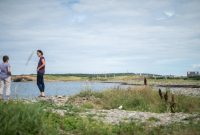Support strong Canadian climate journalism for 2025
This story was originally published by Undark and appears here as part of the Climate Desk collaboration
Perhaps one of the most salient marks of human ingenuity is our ability to peer into places our eyes were never designed to see. We can now glimpse the birth of distant galaxies with the Webb telescope, or spot structures hidden deep inside the human cell through electron cryomicroscopy. And for decades, scientists have been using remote sensing technologies to monitor the planet. From lidar systems creating three-dimensional images of forest biomass to satellite imagery tracking changes in tree cover, these tools can keep watch on ecosystems that serve as the lungs of the planet.
But through an artist’s eye, such technological tools can transcend their scientific purpose to deliver insights about our fast-warming planet that are more likely to resonate with the public.
When photographer Richard Mosse set out to tell the story of climate change, part of the challenge was how to document a complex problem that’s hard to see. He zoomed in on the Amazon, where in 2020, the worst fires in a decade ravaged the rainforest and stretched south to the Pantanal, the world’s largest tropical wetland. The soil there was so parched that fires burned through dried out roots below the earth’s surface.
Mosse was able to capture the subterranean fires hidden to the human eye through a multispectral camera, which uses multiple sensors to gather light reflected off the Earth at discrete narrow bandwidths — a specialized technology that allowed Mosse to document systematic destruction and environmental crimes across remote parts of the Brazilian Amazon over the past five years.
The result, which has appeared in multiple exhibitions worldwide and a new book, shows how techniques drawn from science can help artists, communicators and scientists bring the forces that fuel climate change or destroy nature closer to the public eye. While Mosse doesn’t exclusively rely on scientific tools — for example, some of his work consists of scenes shot in black-and-white infrared film — the way he makes use of imaging technology is a critical part of the narrative. His work demonstrates how such techniques can be leveraged to cut through dry data and help people connect to global issues that matter.

“The thing I found fascinating is that scientists are often processing the numbers, rather than the image or the map — the colours are useful as illustrations,” Mosse told me. “I was very struck by the color palette, as well as it’s double-edged nature: It’s not only aesthetic, it’s also indexical. Those colors reveal something that the human eye can’t see.”
The vibrant palette in his images emerged from combining different bands of multispectral reflectance data, where each band captures distinct details of the terrain. Sorting through them revealed ecological damage, expressed through the images in striking colors not normally associated with scientific mapping. This element of surprise lures the viewer in, and once he has their attention, they’re more primed to receive the message in each image.
In a 74-minute film presented in the exhibition, swathes of lush rainforest appear side by side with cleared land, illegal goldmines or large dams, showing both the scale and pervasiveness of human activity. Such exploits have contributed to record levels of deforestation, a trend that scientists say risks turning the Amazon into a net carbon emitter rather than a carbon sink — which has already begun in parts of the rainforest.
The multispectral imaging Mosse used was first developed to track military targets, but is now also used in Earth observation satellites that help scientists to gauge environmental changes or forecast the weather. The technology touches both sides of the deforestation story: It’s integral to monitoring the destruction of the rainforest, but it’s also popular with agents of that destruction, including famers who monitor soy and companies prospecting minerals.
Each digital sensor in a multispectral drone camera registers a narrow band of spectral reflectance — a function of the light absorbed by different surfaces — to record wavelengths invisible to the human eye. Once the raw images were recorded, Mosse used specialized software to piece together the maps like a jigsaw puzzle and then a digital mapping system to process them further. The exhibited work also exposes what’s invisible to the human eye at the micro scale, through fluorescent microscopic imagery.
Collaborations between artists and scientists are a growing trend, with many inspired by climate change. A project by Google Arts and Culture, for example, invites artists to interpret scientific climate data through online artworks. But Mosse’s approach is distinctive, and other artists, scientists, and communicators can learn from his effective use of scientific tools.
The work is powerful not just visually but in the substance of what it documents, and in how Mosse’s choice of technology reaches across vastly different scales — from aerial views to close-ups of the biome — to expose what’s unfolding deep in the rainforest. It demonstrates that we can, and should, tap science and technology more effectively for fresh ways to tell globally important stories.
“There’s a failure of storytelling,” says Mosse. “What’s missing is artists and storytellers and writers to come together, and to try to help people see what’s happening — because it’s hard to see.”






All images courtesy of the artist, Jack Shainman Gallery, carlier | gebauer, and Altman Siegel Gallery. © Richard Mosse





Comments
This is brilliant. I'd love to see an immersive experience of an inferno sweeping you along and away followed by some of the still, aching beauty like a bird, unseen in a green glade, singing its heart out.